Saturday, 24 July 2010: Luxembourg, mostly on my own
Written 14 August 2010
Saturday morning we woke to find that the pedrestrial square outside our hotel had been transformed into a "brocante" market. "Brocante" would probably be called "antiques" in the USA, but in Europe, it's the category of old stuff that isn't old enough to be considered antique (a couple of hundred years older than what Americans think of as antique). Actually, the brocante was mostly around the sides, as the center, under the trees, is permanently occupied by tables from all the cafés and restaurants that line the square. We lookedat a good deal of it, mainly with books and art in mind, but the only thing we saw that we really liked was a lovely old set of china. We didn't even bother to ask how much it cost, as we had no possible way of getting it safely home to Tallahassee. Among the arrays of goods was a fountain dedicated to Dirks and Lentz, Luxembourg's two native poets, one male and one female, though the guidebook did not say which was which.
At the western edge of the city, we looked down into the parks that occupy the bottoms of the ravines, but we didn't climb all the way down to look at the historical fortified bunkers. (Our friend and colleague Markus Huettel (of FSU Oceanography) spent six years in Luxembourg as a kid and tells us he came to hate those ravines. They must not have lived near a bridge, because every day on his way to school and back, he had to ride his bicycle down all the switchbacks on one side and them back up all the switchbacks on the other! He also said that you used to see Grand Duke Jean and his family walking around in the streets but that times have changed and security has had to be tightened.) We admired the obelisk of the war memorial there, but the golden lady (the "gëlle fra") that usually stands on top was not in her place. We read an account of her adventures over the years, but I lost track of whether her current absence is due to theft or merely maintenance. Just GoogleImage "gelle fra luxembourg" (without the quotes) for a whole series of photos.
As always, I read restaurant menus as we went. At a restaurant call "La Boucherie" (the butcher shop), which specialized in meat, of course, half a dozen different sorts of beef tartare were grouped on the menu as "les grands crus" (the great raw things), a wonderful pun on the usual use of the phrase to mean "the great growths" (of Burgundy wine). A large freestanding poster outside MacDonalds advertised the "Big Beef Parmesano" (just like that, in English), which contained, in addition to the usual burger, lettuce, and tomato, several slices of raw pancetta and large flakes of Parmesan cheese. Not likely to replace the crisp bacon and American cheese in this country.
Next we visited the cathedral, which is dedicated to Mary, Comforter of the Afflicted, and which faces on another large pedestrian square, about half a block away from "ours." That square was filled by a food market, which David, knowing me, took one look at, sat down on the nearest bench, and said, "I'll see you back here in 15 minutes." So I did a quick march through the market, which was a terrific one—I wished I'd brought along the Kindle so that I could have left it with David and felt better about keeping him waiting. The square is also furnished with a huge equestrian statue of one of the Williams of Orange (Guillaume II, I think) flourishing his hat, on a pedestal so tall that he and his horse stood well above the market stalls below.
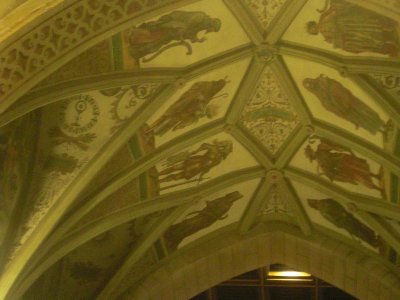
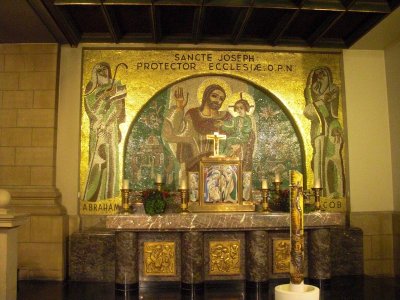 The cathedralwas more colorful than some, as this section of polychrome ceiling shows. Apparently many European churches once had polychrome frescos and painted statuary, though you see very little of it now. It was also graced by a pair of glittering mosaics (of which this is one), very much in the style (including the shiny gold backgrounds) of the Byzantine ones we saw in Ravenna in 2004 (on another trip to a meiofauna congress). The figures in it are about life size. Mary herself, a particular small statue of her held in particular reverance by the populace, stands front of the church holding the baby Jesus and dressed in a embroidered white gown of real fabric. Apparently, she has several such gowns of different designs and colors, although all are lovely and dignified and suitable to her position. She is not "dressed up" seasonally like the mannekin pis.
The cathedralwas more colorful than some, as this section of polychrome ceiling shows. Apparently many European churches once had polychrome frescos and painted statuary, though you see very little of it now. It was also graced by a pair of glittering mosaics (of which this is one), very much in the style (including the shiny gold backgrounds) of the Byzantine ones we saw in Ravenna in 2004 (on another trip to a meiofauna congress). The figures in it are about life size. Mary herself, a particular small statue of her held in particular reverance by the populace, stands front of the church holding the baby Jesus and dressed in a embroidered white gown of real fabric. Apparently, she has several such gowns of different designs and colors, although all are lovely and dignified and suitable to her position. She is not "dressed up" seasonally like the mannekin pis.
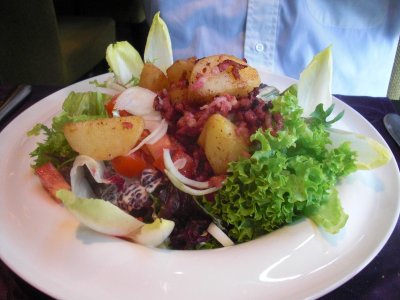
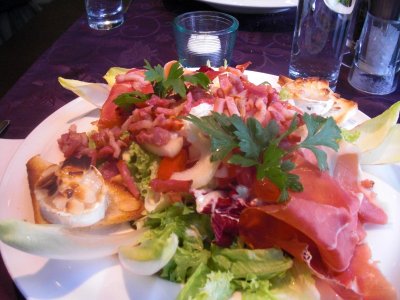 After the cathedral, we walked past the grand-ducal palace, beginning to think about lunch, and David decided he'd had enough for the day. His cold had settled in his chest, and he just wanted to eat lunch near the hotel then go take a nap. So we read a few menus and settled on the Brasserie du Cercle just a couple doors down. We ordered the usual giant salads—David's with lardons and roasted potatoes, mine with ham, grilled goat cheese, and lardons. A blackboard on the wall proclaimed that the current "wine of the month" was Arrogant Frog Chardonnay (with a name like that I though it must be from California, but no, it's in the south of France!).
After the cathedral, we walked past the grand-ducal palace, beginning to think about lunch, and David decided he'd had enough for the day. His cold had settled in his chest, and he just wanted to eat lunch near the hotel then go take a nap. So we read a few menus and settled on the Brasserie du Cercle just a couple doors down. We ordered the usual giant salads—David's with lardons and roasted potatoes, mine with ham, grilled goat cheese, and lardons. A blackboard on the wall proclaimed that the current "wine of the month" was Arrogant Frog Chardonnay (with a name like that I though it must be from California, but no, it's in the south of France!).
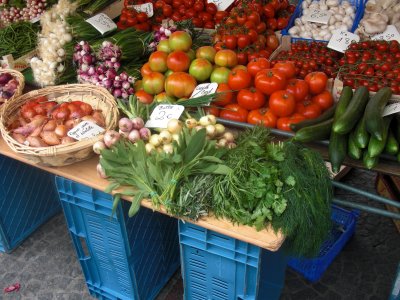
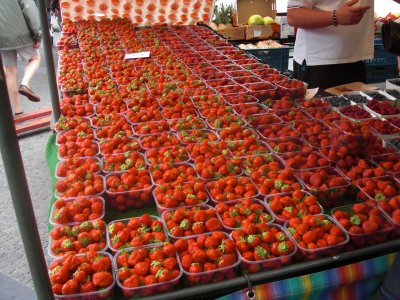 David then retired to the hotel to sleep, and I headed back to the food market, unencumbered this time by the 15-minute limit! I don't know whether this market is an everyday thing, just twice a week, or what. The produce, as usual, was gorgeous! Note that the strawberries are of two different varieties—the left-most five files are rounder, lighter-red berries with large sepals, whereas the last three files are darker red and more conical. Hard to keep from buying any—I had to keep reminding myself that we had reservations at our only Michelin two-star of the trip that evening.
David then retired to the hotel to sleep, and I headed back to the food market, unencumbered this time by the 15-minute limit! I don't know whether this market is an everyday thing, just twice a week, or what. The produce, as usual, was gorgeous! Note that the strawberries are of two different varieties—the left-most five files are rounder, lighter-red berries with large sepals, whereas the last three files are darker red and more conical. Hard to keep from buying any—I had to keep reminding myself that we had reservations at our only Michelin two-star of the trip that evening.
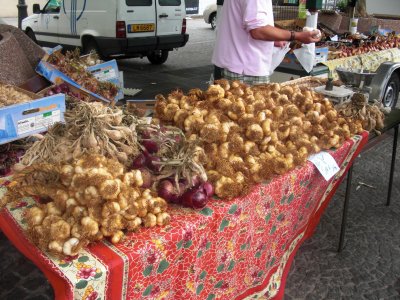
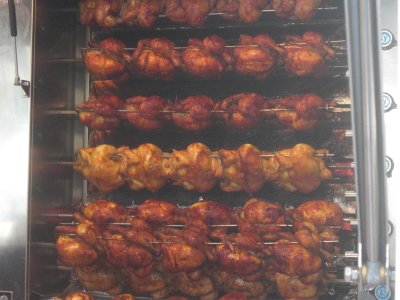 One vendor was selling something I'd never seen before—smoked garlic! A whole table full of it. He would also, by special request, sell you ordinarly fresh garlic and shallots. What a good idea; next time I smoke a trout, I'll have to throw in a head or two of garlic.
One vendor was selling something I'd never seen before—smoked garlic! A whole table full of it. He would also, by special request, sell you ordinarly fresh garlic and shallots. What a good idea; next time I smoke a trout, I'll have to throw in a head or two of garlic.
At the far side of the market, right under Guillaume II's statue, was a large truck, one whole side of which opened up into a counter backed by rotisseries. On the truck was painted a cartoon chicken and "Der Hähnchenkoenig"—The Chicken King! This photo shows only part of one bank of rotisseries. I counted spits, did a little arithmetic, and concluded that just about 100 chickens were roasting away at various stages of doneness. As in France, pounds and pounds of little round potatoes were sizzling in the pan of drippings below. One of these days, I'm going to talk David into just skipping the restaurant and making lunch or dinner from the market! Another stall was selling smoked eel—the only smoked eel I saw on the whole trip, though I studied every restaurant menu carefully.
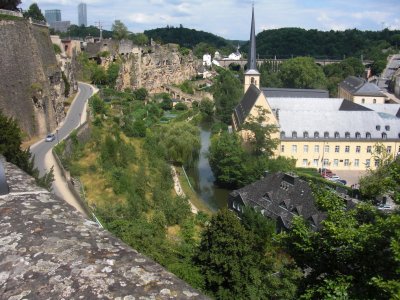
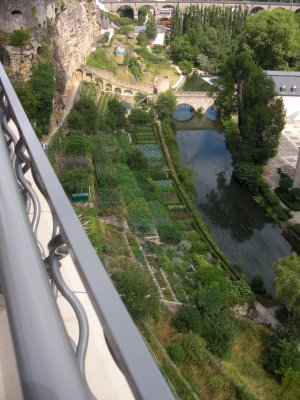 At the end of my tour of the market, I walked back past the grand-ducal palace and was surprised to see a sign advertising tours of the palace. I checked the schedule, noted that tickets were sold only at the tourism office, looked at my watch, concluded I could make it, and set off to book a tour! Unfortunately, the next tour was all booked up, but they had space in the one after that, so I bought a ticket. That left me with an hour to kill, so I just walked around and explored. The eastern edge of the plateau on which the city sits is rightly billed as "the most beautiful balcony in Europe." It's actually a series of balconies—several streets, some for vehicles and some pedestrian, traverse the upper face of the cliffs. Directly below is what's called the "lower town through which the river runs; our restaurant for that night was down there. The left-hand photo shows a particularly picturesque view back along the cliffs from one end (our restaurant for the evening is about a block out of the frame to the right). The viaduct in the distance is the railroad, and a sleek blue train could be seen passing every few minutes. At the right is a closer view of a distant section of the same scene, showing the (slightly telephoto'd) terraced kitchen gardens just at the foot of the cliffs. Many of the buildings along that edge of the city house boutiques and restaurants that take advantage of the view. In the courtyard of one, I saw a topiary bicycle—it might actually have been a real bicycle, entirely covered by tiny clinging vines. The young trees in a small square were enclosed within giant "tomato cages," tapering toward the top and strung with tiny white lights.
At the end of my tour of the market, I walked back past the grand-ducal palace and was surprised to see a sign advertising tours of the palace. I checked the schedule, noted that tickets were sold only at the tourism office, looked at my watch, concluded I could make it, and set off to book a tour! Unfortunately, the next tour was all booked up, but they had space in the one after that, so I bought a ticket. That left me with an hour to kill, so I just walked around and explored. The eastern edge of the plateau on which the city sits is rightly billed as "the most beautiful balcony in Europe." It's actually a series of balconies—several streets, some for vehicles and some pedestrian, traverse the upper face of the cliffs. Directly below is what's called the "lower town through which the river runs; our restaurant for that night was down there. The left-hand photo shows a particularly picturesque view back along the cliffs from one end (our restaurant for the evening is about a block out of the frame to the right). The viaduct in the distance is the railroad, and a sleek blue train could be seen passing every few minutes. At the right is a closer view of a distant section of the same scene, showing the (slightly telephoto'd) terraced kitchen gardens just at the foot of the cliffs. Many of the buildings along that edge of the city house boutiques and restaurants that take advantage of the view. In the courtyard of one, I saw a topiary bicycle—it might actually have been a real bicycle, entirely covered by tiny clinging vines. The young trees in a small square were enclosed within giant "tomato cages," tapering toward the top and strung with tiny white lights.
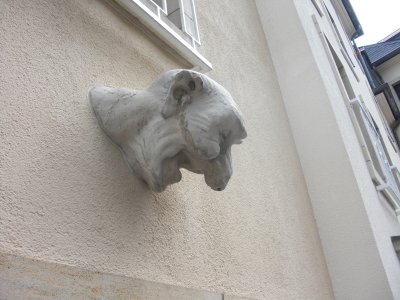
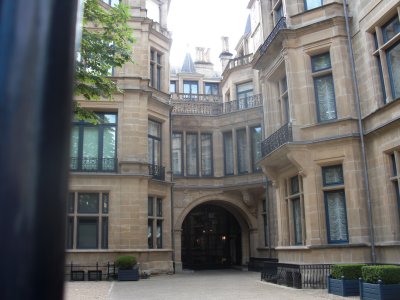 I reported back to the palace in plenty of time for the tour, pausing to take a photo of this wonderful head, protruding from the wall above a doorway, about 10 feet off the ground. A troop of tourists were also taking photos of it, accompanied by a guide who seemed to be explaining it, but I didn't stay to listen.
I reported back to the palace in plenty of time for the tour, pausing to take a photo of this wonderful head, protruding from the wall above a doorway, about 10 feet off the ground. A troop of tourists were also taking photos of it, accompanied by a guide who seemed to be explaining it, but I didn't stay to listen.
The tour rendez-vous point was at the back door of the palace, shown here, which I found more picturesque than the front, which is pretty much flat, with a large balcony from which the grand duke and his family wave on appropriate occasions. The palace isn't actually very big—the façade is wide, but it's only a couple of room deep—and it's just in a street, not facing an open square, so I wasn't able to get a picture of all of it. Under the round arch is a porte cochere that goes all the way through to the front (not actually very far). At the appointed hour, the guide showed up and let us all through a wrough-iron gate into the courtyard where I took the picture.
Unfortunately, photography wasn't allowed inside the palace, but I learned a lot about the Grand Duke's family and how the country works. Luxembourg (in its present form as a grand duchy) was formed in 1815, as part of the same rearrangement that formed Belgium, and the king of the Netherlands was also grand duke of Luxembourg. I don't know what his Dutch name and number were, but he was one of the Williams of Orange and he, he son, and his grandson were accordingly Guillaumes I, II, and III of Luxembourg (apparently Luxembourg wasn't thrilled with them; they hardly ever even came to visit). Then, in 1890, Guillaume III died without a male heir. His daughter Wilhelmina became queen of the Netherlands, but Luxembourg was restricted by something called the Nassau Family Pact to male succession, so the male next of kin, Adolphe of Nassau-Weilberg became grand duke. Like the Williams, he was a protestant. His son, Guillaume IV succeeded him and then (gasp!) married a catholic. The negotiations were apparently long and fraught, but at last an agreement was reached—the sons (i.e., heirs to the throne, or whatever a grand duke sits on) would be reared protestant, and the daughters would be reared Catholic, and on those conditions the pope granted a dispensation and they were allowed to marry. She then proceeded to have a long strings of daughters and never a son. When Guillaume died in 1912, the Nassau Family Pact was apparently no longer in force, because he was succeeded by his daughter Adelaide; the grand ducal family has been Catholic ever since. Adelaide died just a few years later and was succeeded by her daughter Charlotte, who reigned as a much-beloved grand duchess for 46 years before abdicating in favor of her son Jean in 1964 (she died in 1985). He in turn reigned until 2000, when he abdicated in favor of his son Henri, the present grand duke. Henri's mother died a few years ago, but I think Jean is still living. While at university in Switzerland, Henri met and married Maria Theresa, a young Swiss woman of Cuban descent. They have four sons and a daughter. The oldest son, Guillaume, is the heir apparent, called the "hereditary grand duke."
The grand duke and his family actually live at their château, out of town, so the palace serves as the grand duke's office and a venue for state occasions. Tours were being conducted only because they were on vacation; otherwise, the palace would be in use and closed to visitors. Luxembourg is a constitutional monarchy—the elected legislature sits in the same building as the palace, the duke and his cabinet are the executive branch, and I'm assured that "sovereignty resides with the supreme court." Visiting heads of state are put up at the palace, but guest accommodations for anybody else (e.g., mere vice presidents and secretaries of state) are elsewhere. On the tour, we saw the main hall, with its monumental staircase (apparently very familiar to all citizens of the country, as it's where the official photograph for any state occasion is posed; the grand duke always stands on the fourth step, or maybe the fifth, the guide wasn't sure). Strangely, the guide's French wasn't any better than mine—he often consulted his note cards sometimes had to fish for a word, supplied by one of us in the tour group.
Flanking the staircase were a pair of huge and magnificent green malachite vases, a gift from one of the Tsars of Russia when he came to visit. We visited the grand duke's office and the "map room" (an antechamber to the office), saw a beautiful set of tapestries that Charlotte sent off to the U.S. for safekeeping during WWII, and had all the various family portraits narrated. The official portraits of Henri and Maria Theresa are unfinished, because the artist died during the late stages of painting them, but they're beautiful anyway, and the family decided to hang them as they are. They flank the fireplace in the "salle des fêtes," the ceiling of which is painted with beautiful fescoes.
The last item on the tour is the pavement of the port cochere. One of the early grand dukes suffered from insomnia and like to nap in the afternoon. He was frequently disturbed by the terrific noise made by iron-shod hooves and carriage wheels on the stone pavement, echoing under the archway, so he had the stones ripped out and replaced by great end-cut blocks of wood, which are still in place (they don't get so much wear these days, from modern-day rubber tires).
By the time the tour ended, it was time to get back to the hotel to get ready for dinner, but I did take time to detour back through the market for a last look. All the merchants were packing up to leave. The sides of the chicken king truck had been closed up, but the lady in charge was still selling chickens over the tailgate to a few late comers.
Our dinner was at Mosconi, in the lower town, and I realized with surprise that this was the first time we'd ever dined in a highly Michelin or GM rated Italian restaurant. A double check with the hotel's reception desk revealed that our Google maps of the city were not very helpful. He directed us to a large public elevator that would take us down to the lower town and bring us back up—with the vertical component taken care of, the walk was not long. As it happens, we failed to find the upper end of the elevator and wound up walking all the way down the hill, but as soon as we got near the restaurant, we spotted the mouth of the tunnel leading to its downhill end, so we were easily able to take it back up later, in the important direction, as it were.
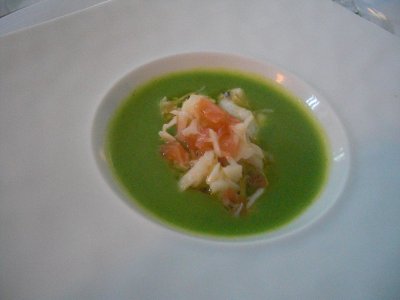
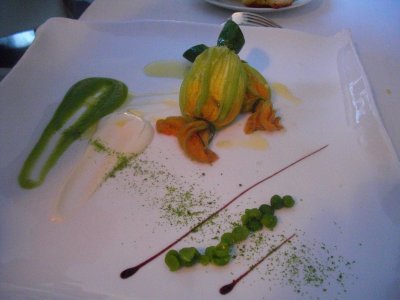 The first amuse-bouche was a single small macaroon (actually a sandwich of two small macaroons with a soft filling) balanced on its edge in the extreme corner of an otherwise bare, white, square plate. Very artistic.
The first amuse-bouche was a single small macaroon (actually a sandwich of two small macaroons with a soft filling) balanced on its edge in the extreme corner of an otherwise bare, white, square plate. Very artistic.
They then served us both a sort of pre-first course of bright-green broccoli soup garnished with a heap of flaked cooked cod and cubed raw salmon. My first course was a warm mushroom and artichoke soup sprinkled with crushed pistachios. It was excellent but not especially photogenic; its smooth beige surface concealed a delicious mixture of sautéed mushrooms. David's first course, on the other hand was spectacularly beautiful. The chef had cut off most of the baby zucchinis still attached to their flowers, diced them, mixed them with a cheese filling and used them to stuff the flowers, which were then poached and served with two sauces and a row of individually peeled cooked green peas. Delicious.
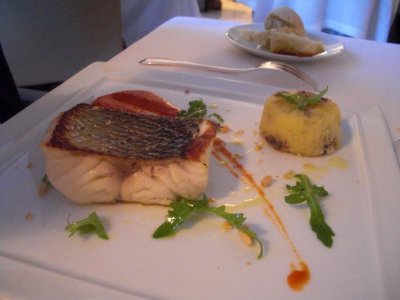
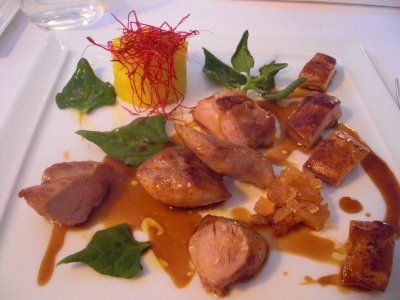 David's main course was "bar de ligne" (line-caught seabass) with a comet of herbed tomato sauce and a timbale of crushed potato. The taste he gave me was superbe, but I still caught him looking enviously at my main course: a varety of small cuts from a roast suckling pig with a rich, slightly sweet sauce, accompanied by a timbale of potato flavored with turmeric (and topped with colorful red onion sprouts) and a little heap of chopped "frutta mostarda" (mustard flavored glacé fruit). Yum! I couldn't identify the greens used to garnish my plate, and neither could the waiter, but he checked with the chef who relayed the word that they were "tetragone" (Tetragonia tetragonioides, New Zealand spinach, Aizoaceae). Very tasty.
David's main course was "bar de ligne" (line-caught seabass) with a comet of herbed tomato sauce and a timbale of crushed potato. The taste he gave me was superbe, but I still caught him looking enviously at my main course: a varety of small cuts from a roast suckling pig with a rich, slightly sweet sauce, accompanied by a timbale of potato flavored with turmeric (and topped with colorful red onion sprouts) and a little heap of chopped "frutta mostarda" (mustard flavored glacé fruit). Yum! I couldn't identify the greens used to garnish my plate, and neither could the waiter, but he checked with the chef who relayed the word that they were "tetragone" (Tetragonia tetragonioides, New Zealand spinach, Aizoaceae). Very tasty.
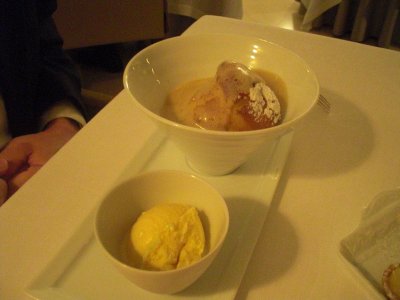
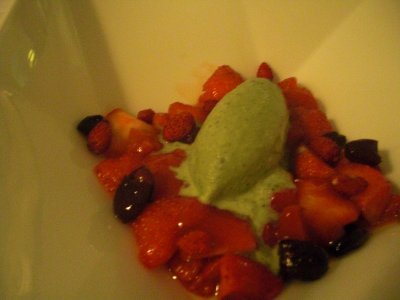 We admired the two laden cheese trolleys but opted to go straight to dessert. In a restaurant of this calibre, though, you don't do straight anywhere, so first we were served a cold soup of red fruits, also sprinkled with pistachios and accompanied by mignardises (tiny lemon tarts and miniature cannoli). Only then could we proceed to the desserts we'd ordered. David's was a baba au rhum, with Marsala zabaglioni, sour cherry jam, and honey ice cream. I had a mixture of wild and domestic strawberries mixed with candied black olives and topped with sweet basil ice cream and vanilla oil. Both scrumptious!
We admired the two laden cheese trolleys but opted to go straight to dessert. In a restaurant of this calibre, though, you don't do straight anywhere, so first we were served a cold soup of red fruits, also sprinkled with pistachios and accompanied by mignardises (tiny lemon tarts and miniature cannoli). Only then could we proceed to the desserts we'd ordered. David's was a baba au rhum, with Marsala zabaglioni, sour cherry jam, and honey ice cream. I had a mixture of wild and domestic strawberries mixed with candied black olives and topped with sweet basil ice cream and vanilla oil. Both scrumptious!
previous entry
List of Entries
next entry

 The cathedralwas more colorful than some, as this section of polychrome ceiling shows. Apparently many European churches once had polychrome frescos and painted statuary, though you see very little of it now. It was also graced by a pair of glittering mosaics (of which this is one), very much in the style (including the shiny gold backgrounds) of the Byzantine ones we saw in Ravenna in 2004 (on another trip to a meiofauna congress). The figures in it are about life size. Mary herself, a particular small statue of her held in particular reverance by the populace, stands front of the church holding the baby Jesus and dressed in a embroidered white gown of real fabric. Apparently, she has several such gowns of different designs and colors, although all are lovely and dignified and suitable to her position. She is not "dressed up" seasonally like the mannekin pis.
The cathedralwas more colorful than some, as this section of polychrome ceiling shows. Apparently many European churches once had polychrome frescos and painted statuary, though you see very little of it now. It was also graced by a pair of glittering mosaics (of which this is one), very much in the style (including the shiny gold backgrounds) of the Byzantine ones we saw in Ravenna in 2004 (on another trip to a meiofauna congress). The figures in it are about life size. Mary herself, a particular small statue of her held in particular reverance by the populace, stands front of the church holding the baby Jesus and dressed in a embroidered white gown of real fabric. Apparently, she has several such gowns of different designs and colors, although all are lovely and dignified and suitable to her position. She is not "dressed up" seasonally like the mannekin pis.
 After the cathedral, we walked past the grand-ducal palace, beginning to think about lunch, and David decided he'd had enough for the day. His cold had settled in his chest, and he just wanted to eat lunch near the hotel then go take a nap. So we read a few menus and settled on the Brasserie du Cercle just a couple doors down. We ordered the usual giant salads—David's with lardons and roasted potatoes, mine with ham, grilled goat cheese, and lardons. A blackboard on the wall proclaimed that the current "wine of the month" was Arrogant Frog Chardonnay (with a name like that I though it must be from California, but no, it's in the south of France!).
After the cathedral, we walked past the grand-ducal palace, beginning to think about lunch, and David decided he'd had enough for the day. His cold had settled in his chest, and he just wanted to eat lunch near the hotel then go take a nap. So we read a few menus and settled on the Brasserie du Cercle just a couple doors down. We ordered the usual giant salads—David's with lardons and roasted potatoes, mine with ham, grilled goat cheese, and lardons. A blackboard on the wall proclaimed that the current "wine of the month" was Arrogant Frog Chardonnay (with a name like that I though it must be from California, but no, it's in the south of France!).
 David then retired to the hotel to sleep, and I headed back to the food market, unencumbered this time by the 15-minute limit! I don't know whether this market is an everyday thing, just twice a week, or what. The produce, as usual, was gorgeous! Note that the strawberries are of two different varieties—the left-most five files are rounder, lighter-red berries with large sepals, whereas the last three files are darker red and more conical. Hard to keep from buying any—I had to keep reminding myself that we had reservations at our only Michelin two-star of the trip that evening.
David then retired to the hotel to sleep, and I headed back to the food market, unencumbered this time by the 15-minute limit! I don't know whether this market is an everyday thing, just twice a week, or what. The produce, as usual, was gorgeous! Note that the strawberries are of two different varieties—the left-most five files are rounder, lighter-red berries with large sepals, whereas the last three files are darker red and more conical. Hard to keep from buying any—I had to keep reminding myself that we had reservations at our only Michelin two-star of the trip that evening.
 One vendor was selling something I'd never seen before—smoked garlic! A whole table full of it. He would also, by special request, sell you ordinarly fresh garlic and shallots. What a good idea; next time I smoke a trout, I'll have to throw in a head or two of garlic.
One vendor was selling something I'd never seen before—smoked garlic! A whole table full of it. He would also, by special request, sell you ordinarly fresh garlic and shallots. What a good idea; next time I smoke a trout, I'll have to throw in a head or two of garlic.
 At the end of my tour of the market, I walked back past the grand-ducal palace and was surprised to see a sign advertising tours of the palace. I checked the schedule, noted that tickets were sold only at the tourism office, looked at my watch, concluded I could make it, and set off to book a tour! Unfortunately, the next tour was all booked up, but they had space in the one after that, so I bought a ticket. That left me with an hour to kill, so I just walked around and explored. The eastern edge of the plateau on which the city sits is rightly billed as "the most beautiful balcony in Europe." It's actually a series of balconies—several streets, some for vehicles and some pedestrian, traverse the upper face of the cliffs. Directly below is what's called the "lower town through which the river runs; our restaurant for that night was down there. The left-hand photo shows a particularly picturesque view back along the cliffs from one end (our restaurant for the evening is about a block out of the frame to the right). The viaduct in the distance is the railroad, and a sleek blue train could be seen passing every few minutes. At the right is a closer view of a distant section of the same scene, showing the (slightly telephoto'd) terraced kitchen gardens just at the foot of the cliffs. Many of the buildings along that edge of the city house boutiques and restaurants that take advantage of the view. In the courtyard of one, I saw a topiary bicycle—it might actually have been a real bicycle, entirely covered by tiny clinging vines. The young trees in a small square were enclosed within giant "tomato cages," tapering toward the top and strung with tiny white lights.
At the end of my tour of the market, I walked back past the grand-ducal palace and was surprised to see a sign advertising tours of the palace. I checked the schedule, noted that tickets were sold only at the tourism office, looked at my watch, concluded I could make it, and set off to book a tour! Unfortunately, the next tour was all booked up, but they had space in the one after that, so I bought a ticket. That left me with an hour to kill, so I just walked around and explored. The eastern edge of the plateau on which the city sits is rightly billed as "the most beautiful balcony in Europe." It's actually a series of balconies—several streets, some for vehicles and some pedestrian, traverse the upper face of the cliffs. Directly below is what's called the "lower town through which the river runs; our restaurant for that night was down there. The left-hand photo shows a particularly picturesque view back along the cliffs from one end (our restaurant for the evening is about a block out of the frame to the right). The viaduct in the distance is the railroad, and a sleek blue train could be seen passing every few minutes. At the right is a closer view of a distant section of the same scene, showing the (slightly telephoto'd) terraced kitchen gardens just at the foot of the cliffs. Many of the buildings along that edge of the city house boutiques and restaurants that take advantage of the view. In the courtyard of one, I saw a topiary bicycle—it might actually have been a real bicycle, entirely covered by tiny clinging vines. The young trees in a small square were enclosed within giant "tomato cages," tapering toward the top and strung with tiny white lights.
 I reported back to the palace in plenty of time for the tour, pausing to take a photo of this wonderful head, protruding from the wall above a doorway, about 10 feet off the ground. A troop of tourists were also taking photos of it, accompanied by a guide who seemed to be explaining it, but I didn't stay to listen.
I reported back to the palace in plenty of time for the tour, pausing to take a photo of this wonderful head, protruding from the wall above a doorway, about 10 feet off the ground. A troop of tourists were also taking photos of it, accompanied by a guide who seemed to be explaining it, but I didn't stay to listen.
 The first amuse-bouche was a single small macaroon (actually a sandwich of two small macaroons with a soft filling) balanced on its edge in the extreme corner of an otherwise bare, white, square plate. Very artistic.
The first amuse-bouche was a single small macaroon (actually a sandwich of two small macaroons with a soft filling) balanced on its edge in the extreme corner of an otherwise bare, white, square plate. Very artistic.
 David's main course was "bar de ligne" (line-caught seabass) with a comet of herbed tomato sauce and a timbale of crushed potato. The taste he gave me was superbe, but I still caught him looking enviously at my main course: a varety of small cuts from a roast suckling pig with a rich, slightly sweet sauce, accompanied by a timbale of potato flavored with turmeric (and topped with colorful red onion sprouts) and a little heap of chopped "frutta mostarda" (mustard flavored glacé fruit). Yum! I couldn't identify the greens used to garnish my plate, and neither could the waiter, but he checked with the chef who relayed the word that they were "tetragone" (Tetragonia tetragonioides, New Zealand spinach, Aizoaceae). Very tasty.
David's main course was "bar de ligne" (line-caught seabass) with a comet of herbed tomato sauce and a timbale of crushed potato. The taste he gave me was superbe, but I still caught him looking enviously at my main course: a varety of small cuts from a roast suckling pig with a rich, slightly sweet sauce, accompanied by a timbale of potato flavored with turmeric (and topped with colorful red onion sprouts) and a little heap of chopped "frutta mostarda" (mustard flavored glacé fruit). Yum! I couldn't identify the greens used to garnish my plate, and neither could the waiter, but he checked with the chef who relayed the word that they were "tetragone" (Tetragonia tetragonioides, New Zealand spinach, Aizoaceae). Very tasty.
 We admired the two laden cheese trolleys but opted to go straight to dessert. In a restaurant of this calibre, though, you don't do straight anywhere, so first we were served a cold soup of red fruits, also sprinkled with pistachios and accompanied by mignardises (tiny lemon tarts and miniature cannoli). Only then could we proceed to the desserts we'd ordered. David's was a baba au rhum, with Marsala zabaglioni, sour cherry jam, and honey ice cream. I had a mixture of wild and domestic strawberries mixed with candied black olives and topped with sweet basil ice cream and vanilla oil. Both scrumptious!
We admired the two laden cheese trolleys but opted to go straight to dessert. In a restaurant of this calibre, though, you don't do straight anywhere, so first we were served a cold soup of red fruits, also sprinkled with pistachios and accompanied by mignardises (tiny lemon tarts and miniature cannoli). Only then could we proceed to the desserts we'd ordered. David's was a baba au rhum, with Marsala zabaglioni, sour cherry jam, and honey ice cream. I had a mixture of wild and domestic strawberries mixed with candied black olives and topped with sweet basil ice cream and vanilla oil. Both scrumptious!